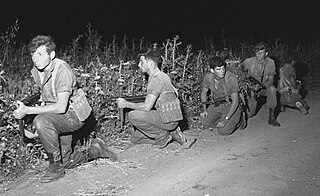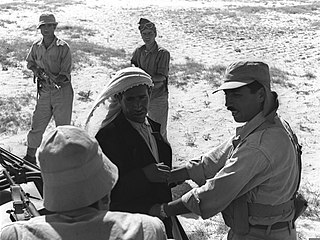| |||||
| Decades: | |||||
|---|---|---|---|---|---|
| See also: | |||||
Events in the year 1953 in Israel.
| |||||
| Decades: | |||||
|---|---|---|---|---|---|
| See also: | |||||
Events in the year 1953 in Israel.
| | This section needs expansion. You can help by adding to it. (August 2010) |
The most prominent events related to the Israeli–Palestinian conflict that occurred during 1953 include:
Notable Palestinian militant operations against Israeli targets
| | This section needs expansion. You can help by adding to it. (August 2010) |
The most prominent Palestinian fedayeen attacks committed against Israelis during 1953 include:
Notable Israeli military operations against Palestinian militancy targets
| | This section needs expansion. You can help by adding to it. (December 2010) |
The most prominent Israeli military counter-terrorism operations (military campaigns and military operations) carried out against Palestinian militants during 1953 include:
The following events took place during 1953 (dates not specified):
|

Commando Unit 101 was a Sayeret unit of the Israeli Defense Forces (IDF), founded and commanded by Ariel Sharon on orders from Prime Minister David Ben-Gurion in August 1953. They were armed with non-standard weapons and tasked with carrying out retribution operations across the state's borders—in particular, establishing small-unit maneuvers, activation and insertion tactics.
This timeline of the Israeli–Palestinian conflict lists events from 1948 to the present. The Israeli–Palestinian conflict emerged from intercommunal conflict in Mandatory Palestine between Palestinian Jews and Arabs, often described as the background to the Israeli–Palestinian conflict. The conflict in its modern phase evolved since the declaration of the State of Israel on May 14, 1948 and consequent intervention of Arab armies on behalf of the Palestinian Arabs.

The Qibya massacre occurred during Operation Shoshana, a reprisal operation that occurred in October 1953 when Israeli troops under Ariel Sharon attacked the village of Qibya in the West Bank, which was then under Jordan's control, and killed Palestinian civilians.

Moshe Dayan was an Israeli military leader and politician. As commander of the Jerusalem front in the 1948 Arab–Israeli War, Chief of Staff of the Israel Defense Forces (1953–1958) during the 1956 Suez Crisis, but mainly as Defense Minister during the Six-Day War in 1967, he became a worldwide fighting symbol of the new state of Israel.

The 1949 Armistice Agreements were signed between Israel and Egypt, Lebanon, Jordan, and Syria. They formally ended the hostilities of the 1948 Arab–Israeli War and also demarcated the Green Line, which separated Arab-controlled territory from Israel until the latter's victory in the 1967 Arab–Israeli War.
This page is a partial listing of incidents of violence in the Israeli-Palestinian conflict in 2004.
Meir Har-Zion was an Israeli military commando.

Palestinian return to Israel refers to the movement of Palestinians back into the territory of present Israel.

Hashemite Kingdom of Jordan/Israel Mixed Armistice Commission was the United Nations organisation of observers which dealt with complaints from Jordan and Israel to maintain the fragile cease fire along the demarcation line between Israel and Jordan. At the closing of the 1948 Arab-Israeli War, on 3 April 1949, the Hashemite Kingdom of Jordan signed a truce with Israel called the 1949 Armistice Agreements. The United Nations Truce Supervision Organization posted Military Observers as part of the Mixed Armistice Commissions (MACs) to Observe the truce on the Cease fire line and to liaise with the Israeli and Jordanian local area commanders. While the 1948 war was concluded with the 1949 Armistice Agreements it has not marked the end of the Arab–Israeli conflict. The HKJ/IMAC was the organisation which monitored the Jordan/Israel truce agreement, the HJK/IMAC Headquarters was located in Jerusalem close to the Green Line and, through close liaison with the UNTSO headquarters in Government House, Jerusalem, was charged with supervising the truce, investigating border incidents, and taking remedial action to prevent the recurrence of such incidents along the Jordan/Israel Green Line.
The 1952 raid on Beit Jala was a part of the reprisal operations that were carried out by Israel in response to Arab fedayeen attacks from across the Green Line. It involved an Israeli incursion into Beit Jala, a town in the Jordanian-annexed West Bank, on 6 January 1952, after which three houses were rigged with explosives and subsequently blown up; the attack killed seven civilian residents. After the attack, the perpetrators left leaflets at the site that were written in Arabic and explained the nature of the killings as a "penalty" for the earlier rape and murder of an Israeli Jewish girl by Palestinian Arab infiltrators, who were supposedly locals of Beit Jala, in the neighbourhood of Bayit VeGan in Jerusalem.

Reprisal operations were raids carried out by the Israel Defense Forces in the 1950s and 1960s in response to frequent fedayeen attacks during which armed Arab militants infiltrated Israel from Syria, Egypt, and Jordan to carry out attacks on Israeli civilians and soldiers. Most of the reprisal operations followed raids that resulted in Israeli fatalities. The goal of these operations – from the perspective of Israeli officials – was to create deterrence and prevent future attacks. Two other factors behind the raids were restoring public morale and training newly formed army units. A number of these operations involved attacking villages and Palestinian civilians in the West Bank, including the 1953 Qibya massacre.
Events in the year 1965 in Israel.
Events in the year 1958 in Israel.
Events in the year 1956 in Israel.
Events in the year 1955 in Israel.
Events in the year 1954 in Israel.
The Yehud attack was an attack on a civilian house in the village of Yehud carried out by a Palestinian fedayeen squad on 12 October 1953. Three Israeli Jewish civilians, a mother and her infant children, were killed in the attack.

A Gaza–Israel conflict escalation began on 3 May 2019 after two Israeli soldiers were injured by sniper fire from the Gaza Strip during the weekly protests at the Gaza–Israel border. In response, the Israeli Air Force carried out an airstrike, killing two Palestinians. Following this, hundreds of rockets were launched from Gaza at Israel, while the Israeli Air Force struck numerous targets within the Gaza Strip. In addition, Israel increased its troop presence near the Israel–Gaza barrier.
The Israel Defense Forces (IDF), the military forces of the State of Israel, has on several occasions been involved in incidents that resulted in accusations of misconduct or potential breaches of international law. In some instances, initial official statements or denials were later revised following internal investigations, which subsequently acknowledged wrongdoing or provided more clarity on events. This article documents such instances, emphasizing the timeline from initial denial to subsequent acknowledgment.